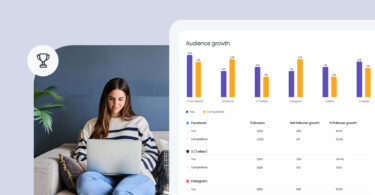Keeping tabs on your competition has become necessary in the process of becoming a market leader. Competitor analysis is the process of analyzing your competition and then monitoring them on an ongoing basis, and understanding their behavior.
With the advent of new software and technology, marketers, and business owners can perform a better competitor analysis. It is important to regularly conduct a thorough analysis of your competition in order to stay one step ahead.
Here are 5 major steps you should be performing to execute a seamless competitor analysis:
- Figure out competitors
- Perform thorough research
- Gather comparative market information
- Analyze competitive information
- Determine your competitive position
Figure Out Competitors
Some businesses think it is best to get on with their own plans and ignore the competition. But that should not be the case. Before figuring out your competition, distinguish it into either of the two basic types:
- Direct
- Indirect
While direct competitors are the ones, who produce the same product or service just as you do, indirect competitors are the ones who produce a substitute for your product or service. To cite an example: A direct competitor for a producer of pens would be another firm that produces similar kinds of pens.
An indirect competitor would be the one who produces a pencil (a substitute for a pen). Staying abreast of your direct competitor’s products, marketing strategy, distribution channels, etc. is a good practice to follow. It is equally important to keep tabs on your indirect competition. This is one of the basic steps of performing a competitor analysis.
Perform Thorough Research
With a list of competitors in your bag, where do you go next? Before deep-diving into the analytics and assessing your competitor’s information, you should conduct market research of your competition. You’ll get a clear picture of your competitor’s foothold in the market. Asking questions to your target audience such as :
- What do you find great about <competitor name>?
- Do you think <competitor name’s product> needs an alternative?
- Is your <competitor’s product> an expensive one?

By asking these kinds of questions to your “potential” consumers, you are effectively judging your scope in the current market scenario. Once the firm starts to grow, hiring a professional agency to carry out market research makes more sense to churn out the best of results for you. Questions ranging from market strategy to total sales volume can further deepen your insights from the competitor analysis.
Gather Comparative Market Information
Competitive information is available from a variety of resources such as promotional advertisements, sales brochures, newspaper and magazine articles, etc. An advertisement not only tells you a competitor’s price and other product information but also provides an indication of your competitor’s promotional program and budget. When reading a competitor’s advertisement pay close attention to the following: publication, frequency, special offers, product features, and benefits highlighted.
Sales brochures are one of the best sources to rely on as far as the competitor analysis is concerned. They let you know how your competitor is positioning their product and company. You also come to know about the features and benefits they are highlighting to attract more sales.

Newspapers and magazines are great sources to refer to while gathering competitor’s information. Informative articles in the newspapers and magazine can give you relevant facts and figures about your
- competitor’s growth
- competitor’s decline
- an evolving strategy.
Lastly, sales staff probably has more access to competitive information than anyone else in your organization. Customers often show salespeople sales literature, contracts, price quotes, and other information from competitors. Encourage your sales staff to be inquisitive and try to get maximum information about your customers, even ask for their promotional material. Hearing straight from the customer’s mouth can give you information that can be leveraged later to drive campaigns or plan a strategy.
Analyze Competitive Information
The next step that follows is the exhaustive analysis of the gathered data. Data such as marketing strategy, targeted market segments, growth rate, etc. can help make deepen your insights on your competitor’s position.

Certain areas to garner your focus, as far as the competitor market analysis is concerned, are:
The Product
List out all product features and benefits and tick mark which competitor of yours is providing what features/benefits. This can effectively help you in comparing your product to the other products prevalent in the market. Simultaneously, you also get an answer to the question: How does your product compare to your closest competitor’s product? This will help you decide on, what to include and what to discard, features that you were initially offering your consumers.
Price

More often than not same products end up having different prices. If your price for a similar product is higher than your competitor’s, then your market position is weaker; and if it’s lower, then your competitive position is better. A trend of lowered prices may indicate that your competition is doing it to gain market share and improve production costs. It could also mean your rival is in financial trouble and has been forced to lower prices.
Market Share
The most widely used measure of sales performance. It simply tells you your competitor’s hold over the market for a certain product or service. A major share might suggest a complete monopoly. A small percentage of various competitors reads as “excess competition” for a product or service. By dividing your competitor’s sales volume by the total market volume, you can derive the percentage market share of your competitor.
Determine your Competitive Position
You have coalesced and extracted analytics of your competitor and the market. Now is the time for you to draw valuable inferences from the competitor analysis and work on them. Inferences such as:
Advantages and Disadvantages
Identify the key parameters that can be advantageous or disadvantageous to you and your business. Similarly, you can examine the competitive environment for your product/service and accordingly make smart changes to your strategy.
Problems and Opportunities
Now you are in a better position to summarize the problems and the opportunities pertaining to your industry. With the competitor analysis, you can also inspect how have the problems been addressed and how have the opportunities been capitalized.
Objectives and Strategies
For each competitor in your analysis, you should try to identify what their market objectives are. Also, try and determine what types of strategies they are using to achieve them. Once you have identified what your competitors are trying to achieve, you will need to determine what type of strategy they have employed. Later you can counteract with a strategy of your own.
Birdeye, a powerful online reputation management software, provides you with a comprehensive competitor analysis tool that helps you analyze the competition.
Originally published









